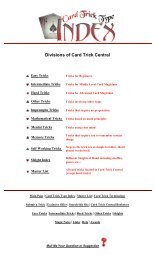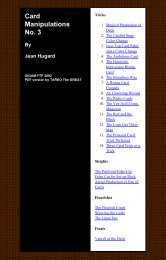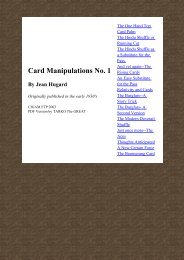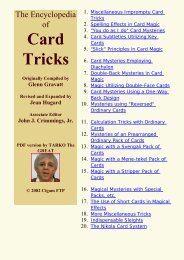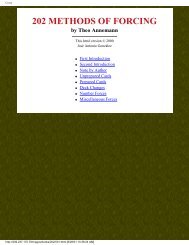Card Manipulations No. 4 By Jean Hugard - Umclidet
Card Manipulations No. 4 By Jean Hugard - Umclidet
Card Manipulations No. 4 By Jean Hugard - Umclidet
You also want an ePaper? Increase the reach of your titles
YUMPU automatically turns print PDFs into web optimized ePapers that Google loves.
<strong>Card</strong> <strong>Manipulations</strong> <strong>No</strong>. 4<br />
<strong>Jean</strong> <strong>Hugard</strong><br />
Next | Previous | Contents<br />
Substitutes for the Pass<br />
a. Break and Overhand Shuffle<br />
b. The Riffle Return<br />
c. Reversed <strong>Card</strong> as Indicator<br />
A great number of different moves have been evolved for<br />
controlling a chosen card without the use of the pass. <strong>By</strong> request I<br />
give three of the best.<br />
a. The Break and Overhand Shuffle<br />
A card having been drawn do not simply cut the pack for its<br />
replacement, a suspicious and inartistic procedure. Rather spread<br />
the pack fanwise and as the person extends his hand with the card,<br />
divide the fan about the middle, push it forward and actually take<br />
the card from him, for all the world as if you were using a forceps.<br />
You do not, of course, snatch the card, but work smoothly and<br />
without hesitation. Instantly close the fan, inserting the tip of the left<br />
little finger above the card.<br />
Remove your right hand for a moment, allowing all to see that the<br />
outer end of the pack is closed and regular. Fig. 13.<br />
Take the pack, from above between the right second finger, at the<br />
outer end, and the ball of the right thumb, at the inner end. Press the<br />
thumb tightly against the pack, retaining the break made by the left<br />
little finger. Remove your left hand for a moment making some<br />
gesture, appropriate to your patter, again allowing the outer end of<br />
the pack to be visible, the break at the back being out of sight,<br />
unless you allow someone to stand directly behind you. Fig. 14.<br />
Proceed to an overhand shuffle<br />
by placing the pack in the fork of<br />
your left thumb, which then turns<br />
the pack down as if it were<br />
pivoted at the tips of the right<br />
second finger and thumb of your<br />
right hand, the break being<br />
retained by the ball of the thumb.<br />
Fig. 15.<br />
Shuffle the cards in the usual way<br />
until the break is reached, then throw the rest of the cards on top.<br />
The chosen card is thus brought to the top of the pack, ready to be<br />
dealt with in any way desired for the purpose of the trick in hand,<br />
without any irregular or quick movement; indeed, the sleight should<br />
be executed rather slowly, giving the onlooker every opportunity of<br />
seeing how honest the procedure appears from the front.<br />
b. The Riffle Return<br />
In this method you allow the drawer of the card to push it into the<br />
deck as you riffle the outer end. Prevent the card from going flush<br />
with the rest by holding the inner end of the pack tightly. Fig. 16.<br />
Draw the deck back, covering it with the right hand, and, under<br />
cover of squaring the cards, push the outer end of the card a little<br />
over to the left and then downward diagonally, so that its left top<br />
and right bottom. The left little finger at once straightens the card by<br />
pressing on the right lower corner. The selected card will now<br />
project from the lower end of the pack. Fig. 17, A, B and C.<br />
Divide the deck at the projecting card, taking off the top half, and<br />
this card, with the right hand, and proceed at once to a riffle shuffle.<br />
The position in which the cards are held allows you to sight the<br />
chosen card without arousing any suspicion on the part of the<br />
spectators. You may put it at the bottom of the pack by allowing it<br />
to drop first, or you may place it second, third or fourth from the<br />
bottom by letting one, two or three cards drop from the left hand<br />
packet first.<br />
Illustrations <strong>No</strong>s. A, B and C are exaggerated for the sake of<br />
clearness. The card should protrude an eight of an inch at the<br />
utmost, and, with practice, it may be allowed to project so slightly<br />
as to be practically imperceptible except to the touch.<br />
c. Reversed <strong>Card</strong>s as Indicator<br />
This is rather a barefaced procedure, but it is very useful at times to<br />
baffle a skeptical spectator who may have an inkling of the usual<br />
methods. In spreading the cards for one to be chosen push the<br />
bottom card well into the fork of the left thumb, then, as you close<br />
the pack, lift all except this card slightly. At the same moment, press<br />
the tips of the right fingers against the right side of this bottom card<br />
and move the left hand to the right, so that the card is turned face up<br />
under the rest of the cards. The move is made under cover of<br />
closing the spread of card and is imperceptible.<br />
While the card is being noted, make a free overhand shuffle, simply<br />
retaining the bottom card in position. Then undercut about half the<br />
deck, have the card replaced on the portion in the left hand and drop<br />
the undercut on top. Square the deck very openly and tap both sides<br />
and ends on the table, plainly showing that there is no break or<br />
jogged card, but be careful not to mention these artifices. If any of<br />
your audience know about these processes they can see you are<br />
using them, so why suggest them to others who are ignorant of their<br />
possible use. You may have occasion to use them in another trick<br />
later on.<br />
To get control of the chosen card and right the reversed card, you<br />
may divide the deck, riffling the inner end with the right thumb,<br />
dividing the pack at the reversed card, and, by a riffle shuffle, send<br />
that card to the bottom and the chosen card to the top. Pull up your<br />
left sleeve with the right hand and with the pack in the left hand pull<br />
up your right sleeve. It is an easy matter then to turn the bottom card<br />
over with the fingers against the sleeve under cover of the forearm.<br />
Or, standing with your right side to the front, shuffle the pack<br />
overhand. Shuffle freely till you have almost reached the reversed<br />
card, then run the cards off singly When the reversed card shows<br />
up, thumb it right off the pack and let it fall on the floor. At once<br />
drop the rest of the cards on top of those shuffled off into your left<br />
hand, thus bringing the drawn card to the top. Apologize for your<br />
clumsiness and pick up the fallen card, casually inquiring if it is the<br />
selected cards, as if you didn't know.<br />
The use of these three entirely different means of controlling a card,<br />
combined with an occasional regular pass, will throw the onlookers<br />
entirely off the trail. It is advisable, when working out the details of<br />
a particular trick to apply one of these methods to it and thereafter<br />
stick to that particular move for that trick. This will help in attaining<br />
that smoothness of execution which is so necessary to success.<br />
Next | Previous | Contents



